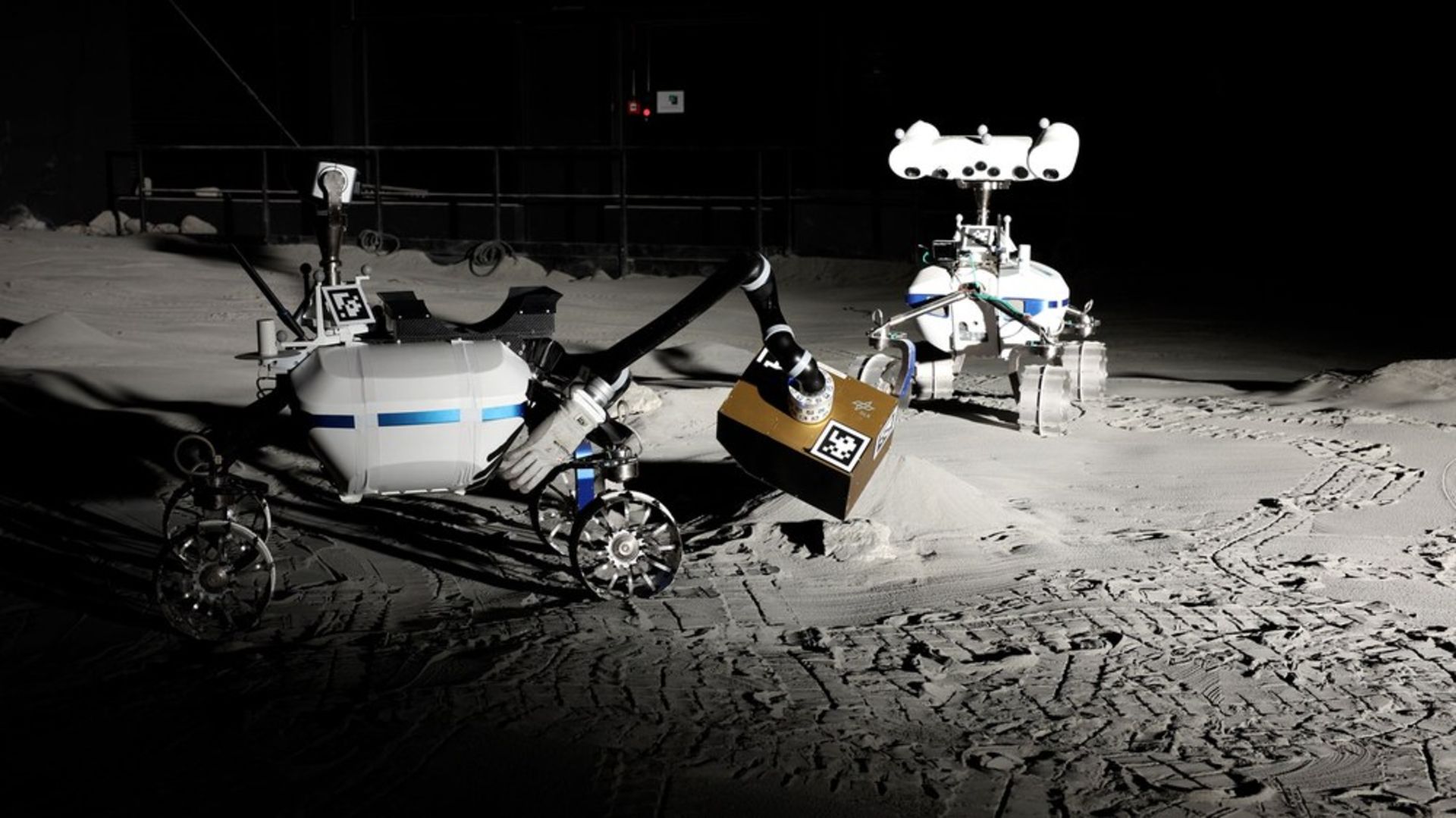Ken Pomeroy
Courtesy of the artist
…

Ken Pomeroy
Courtesy of the artist
…

In a scene that could be out of a Pixar movie, two adorable robots crawled across a simulated surface of the moon in search of water. One rover even looks a bit like WALL-E.
The excursion is not for entertainment, however. It’s a recent…

Building on the momentum of consumer boycotts against Target and other companies earlier this year, grassroots organizers want American consumers to use their economic power this Thanksgiving weekend to protest the Trump administration’s anti-immigration and anti-DEI crackdowns – and the big corporations that won’t oppose them.
The We Ain’t Buying It campaign – organized by many of the groups behind the No Kings protests – is asking Americans to stop shopping at Target, Home Depot and Amazon on Black Friday, one of the busiest retail days of the year, while also encouraging people to shop local and support community businesses.
“We are reclaiming our power. We are redirecting our spending. And we are resisting this rise to authoritarianism,” said LaTosha Brown, co-founder of Black Voters Matter, one of the groups spearheading this action.
Organizers see We Ain’t Buying It as an economic pressure campaign that fits into the broader civil resistance against the president’s agenda. It joins other economic protests launched during the Trump era, including an ongoing boycott against Target for rolling back its DEI policies and an uptick in people cancelling their Disney+ and Hulu subscriptions after ABC’s suspension of late-show host Jimmy Kimmel.
Consumer activism, including boycotts, can bring meaningful attention to causes, experts said. But whether something like We Ain’t Buying It can prod governments or institutions to change positions depends on what organizers seek to achieve – and how sustained and visible the public pressure.
“They’re effective not so much because they actually reduce sales that much,” said Nien-hê Hsieh, professor of business administration at Harvard Business School. “But it’s really about calling attention and putting the company in the spotlight.”
We Ain’t Buying It is targeting three companies, though organizers said they hope to send a message to all businesses willing to cower to the Trump administration.
On the list is Amazon, which has already faced buying blackouts from groups like the People’s Union USA for donating to Trump’s inaugural fund and reaping major corporate tax cuts. Home Depot is also a target because Immigration and Customs Enforcement (ICE) has reportedly singled out their properties for immigration arrests. Protesters have gathered outside Home Depot locations in US cities such as Charlotte and Chicago to push back against the immigration raids. (Home Depot spokesperson George Lane told the Guardian that the company “isn’t notified that immigration enforcement activities are going to happen, and we aren’t involved in the operations”.)
Action is also directed at Target for its rollback of its DEI goals, something that has already inspired sustained consumer boycotts this year, especially by Black activists and consumers. In its third-quarter earnings, Target reported a 1.5% drop in net sales, and its stores recorded a 2.2% decline in foot traffic. In August, Target announced its CEO was stepping down, citing inflation, tariffs and the boycott for slipping sales. The company just had its first major layoffs in a decade.
Organizers plan to keep adding pressure. In addition to Black Voters Matter, groups such as Indivisible, 50501, Until Freedom and the Working Families party have not only helped organize the boycott, but have also been behind the larger civic movements against the second Trump administration. Brown said since the We Ain’t Buying It launch earlier this month, more than 80 other groups have signed on to participate, including labor unions.
“We’re hoping that the millions of people that participate in this will have a higher level of consciousness of that we have choice, that our money gives us choice,” Brown said. “That means that we have power and that we can make choices to demand better.”
The weekend boycott begins on Thanksgiving, when the motto is “Don’t spend a dime, spend time with your family,” Brown said. Organizers encourage people not to shop at all on Black Friday, unless it’s at small or local businesses. Shopping locally is also the goal for Saturday. Sunday is focused on mutual aid, and Cyber Monday will be a “cyber shutdown”, Brown said, meaning no online shopping.
“We have people who are deleting their apps,” Brown said. “We’re going to cancel subscriptions. We’re not buying anything.”
The We Ain’t Buying It organizers see this campaign as bigger than a boycott of these specific companies. The campaign is asking participants to reinvest back into their communities and pledge to be conscious consumers. They’ve released a toolkit for partners, and are encouraging people to post on social media.
Even if We Ain’t Buying It ends after Monday, organizers see this economic pressure as one of the many tools to deploy to counter the Trump administration and protect American democracy. “It’s actually a relay race. It’s a hand-off between different actions and different groups,” said Hunter Dunn, national press coordinator for 50501.
Dunn said that includes mass mobilizations, like the recent No Kings protest, as well as local organizing, mutual aid and consumer activism, such as boycotts.
“We need to push back against this administration and the billionaire elites backing it,” Dunn said. “This is just one piece of a larger puzzle.”
We Ain’t Buying It joins a tradition of Black Friday protests that have sought to raise awareness about everything from the climate crisis, to worker and labor rights, to overconsumption. These actions can raise the salience of these issues, especially among would-be shoppers who care about these causes.
“We’ve had Black Friday boycotts since Black Friday has been around,” said Emily E LB Twarog, associate professor at the School of Labor and Employment Relations at the University of Illinois Urbana-Champaign.
“‘Don’t buy on Black Friday’ because of how workers are being treated in big box stores or around anti-sweatshop campaigns, and now in response to Trump and ICE. I think that they’re worthy of doing, I just don’t know how systemically effective they are.”
Experts say how successful these efforts are can be difficult to measure – and it can depend a lot on the organizers’ goals. If the aim is to cut into a company’s sales or force it to change its practices, that can be much harder to achieve, especially for digital or one-off protests. But if the goal is attention, consumer activism can be very valuable.
“Is it to raise awareness right about these things, so that people have a deeper understanding and maybe make some political decisions based on that knowledge?” Twarog said. “Then I think it’s highly effective because you’re able to share that information.”
Economic activism can help change the practices of governments and institutions, whether it’s the farm workers strikes of the 1960s, or the anti-apartheid boycotts against South Africa in the 1980s, or even the anti-sweatshop protests against Nike in the 1990s. But as Paul Sergius Koku, professor emeritus at Florida Atlantic University College of Business, said: “It has to be sustained over time, and you have to give reasons for people to buy into it.”
That requires spreading awareness and attention beyond eager activists to include a wide range of participants willing to sacrifice – even by just paying higher prices – for a cause. Plus, Koku said, companies don’t just sit back and take it; they could also do their own public relations or lower prices to counter the opposition.
Twarog said she expects that the economic impact of many of today’s consumer boycotts are likely regional or localized, possibly in communities most affected by Trump’s policies, such as hers, in Chicago, where ICE is conducting raids and the national guard is deployed. But retailers like Amazon and Target are huge companies that have faced pressure and backlash before. As Twarog put it: “Is it just the cost of doing business – withstanding these trends?”

Top deals
Searching for a new pair of running shoes? Black Friday 2025 is just a few days away – and the deals are coming thick and fast. You can already bag big discounts on some top-rated trainers from the likes of Nike, Adidas and Hoka, and…

Data-driven smog control in Punjab gives citizens accurate, timely, and accessible information about air quality
For generations, the onset of winter in…

Indian film star and Bollywood icon Dharmendra has died aged 89.
One of the nation’s most popular actors, he was a defining presence in Indian cinema in the 1970s and 1980s.
A senior police official who spoke to Dharmendra’s doctor…

Acute coronary syndrome (ACS), comprising ST-segment elevation myocardial infarction (STEMI), non-STEMI (NSTEMI), and unstable angina, continues to impose a substantial burden on public health.1 Each year, an estimated 7–9…

Dystrophinopathy, an X-linked recessive disorder caused by pathogenic variants in the DMD gene, covers a phenotypic spectrum that includes X-linked dilated cardiomyopathy, Duchenne muscular dystrophy (DMD), and Becker muscular…

Ohio State vs. Mount St. Mary’s
Date: November 25, 2025
Time: 6:30 p.m.
Venue: Value City Arena – Columbus, Ohio
TV: BTN
Listen: Ohio State Radio Network from Learfield
Live Stats: Sidearm
Rosters: Ohio State | Mount St. Mary’s
Season…